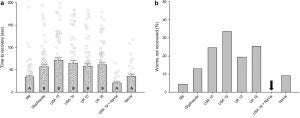Newsflash: Study links common weedkiller to animal convulsions! The culprit? Old reliable Roundup.
Amid a backdrop of multimillion judgements (for Roundup’s tenuous links to cancer), this headline affirms what many have long suspected — another in a long list of Monsanto maladies foisted on an unsuspecting world. Not only is Roundup supposedly a carcinogen (a contention that would do little more than put it on par with Disneyland, coffee, fishing poles, and working the night shift), it’s also a potent neurotoxin, according to this new research! A double whammy of the highest order.
From a legal standpoint, since a court of law found Bayer (now the owner of the Roundup IP) liable for cases of non-Hodgkin’s lymphoma, it must be so. For many in the public sector, that’s the damning final word. Except that a finding of guilt isn’t always predicated on sound science, but an appeal to emotions. Judges and juries are horrible arbiters of scientific truth.
But what happens when science seems to adjudicate “guilt” using a rigorous framework of inquiry and experimentation? That should (in theory) support the findings, while raising the confidence bar.
As an applied scientist, I was tasked to evaluate a recent peer-reviewed paper — a controversial one at that. In a nutshell, the study out of Florida Atlantic University exposed a model organism called Caenorhabditis elegans (a small roundworm, commonly used as a “lab rat” of sorts) to the active ingredient glyphosate (formulated and branded as Roundup or any number of generically named alternatives).
It was found that exposure at levels significantly lower than established limits induced non-recoverable convulsions (seizures) — prompting questions about neurotoxicity in animals and humans. Essentially, it short-circuited neurological signaling by causing a crippling backlog. When the scientists administered an anti-epilepsy drug, the clogged spigot was opened and C. elegans fully recovered.

They argue that this is deserving of more attention, especially since 1) Roundup is among the most widely used herbicides — and only slated to increase, and 2) the equivalent chemical pathway in humans (that glyphosate can potentially interfere with as a neurological target) regulates locomotion, sleep, and mood. This can potentially extend to epilepsy, anxiety, depression, and over the long term, Parkinson’s disease.
The research team opened with a sobering fact: Over 80 percent of urine samples from adults and children had detectable levels of glyphosate, according to the Centers for Disease Control and Prevention. They neglect to say if these quantities were above acceptable thresholds (doubtful), or if this was merely a presence/absence test (most likely). I’m not particularly worried, since glyphosate is expunged from the body very quickly. In addition, current instrumentation and testing procedures have insane degrees of sensitivity and discrimination, so a “hot” test functionally means little. We’re talking parts per billion (or more) of a chemical that has a short residence time. An exhaustive body of knowledge (40+ years) vouches for this fact.
The researchers reported observable effects in C. elegans at glyphosate concentrations 300 times less (0.002 percent) than what’s recommended for consumer use. Disheartening, for sure. But this doesn’t resolve the whole experimental picture.
The protocol called for inducing seizures by zapping (electroshocking) the nematodes to temporarily overwhelm their neurological system. It wasn’t the glyphosate (or Roundup) that induced seizures upon exposure. These merely “spiked” (increased) recovery time due by antagonizing specific neurological pathways. In effect, glyphosate/Roundup muffled the signals, extending the epileptic episode. Fair enough. But the specific strain of nematodes used were known to be especially vulnerable to “signal muffling” and naturally have extended convulsion times when stressed!
This harks back to another study — the infamous Séralini “study.” This (now retracted) paper posited that rats on a long-term GMO corn diet developed tumors. However, the specific lab strain of rats used were known to spontaneously develop tumors, invalidating the findings.

As a farmer, I also have questions about the concentrations referenced in the paper. The researchers reference consumer concentrations, rather than commercial rates, which is 22 fl oz of Roundup per acre. This represents the bulk of applications worldwide. In grade school, I was always taught to show my work. If we assume a typical soil can hold 1 inch of water per foot, and an acre-foot of water (one acre of real estate, one foot [12 inches] deep) is 326,000 gallons, then a typical acre soil profile would have 27,167 gallons of water. Convert 22 fl oz Roundup to gallons = 0.17 gallons. Divide 0.17 by 27,167 gallons: equals roughly 0.0006 percent Roundup by volume. This means that the values stated by the researchers are over 3x greater than that actually found in a soil water environment — not taking into account 1) constant degradation through biological and environmental means and 2) the fact that Roundup isn’t 100 percent glyphosate to begin with (due to other ingredients in the formulated recipe)!
In fact, Roundup is only ~50 percent active ingredient, the balance are various co-formulants that improve the products properties (sprayability, etc.). The researchers found that Roundup caused more unrecoverable seizures than glyphosate alone. Deductive reasoning suggests that the inerts are primary contributor then, not the much maligned active ingredient.
Concerns about effects on other soil dwelling organisms were stated, but C. elegans generally isn’t found in the “natural” environment, let alone soil — but in decaying vegetation and other human influenced settings.
Finally, chronic exposure and accumulation are referenced as risk factors. Risk equals hazard times exposure. Low hazard x low exposure gives an overall composite risk index of low. And again, glyphosate doesn’t accumulate in the human body.
Most importantly, what’s the real world translatability of the findings? Is a: 1) perpetual bath in glyphosate infused water, 2) with an outstretched lightning rod in hand, 3) by a cherry picked, especially vulnerable population — a reasonable scenario?
With little evidence, Roundup has literally been implicated in every conceivable human malady. The cacophony of voices predicting doom has intensified of late. Based on an objective analysis of the given narrative, I can’t in good professional conscience add glyphosate to a dossier of suspect compounds. To me, it seems like another case of fishing for preordained outcomes — with literal (round)worms.
Tim Durham’s family operates Deer Run Farm — a truck (vegetable) farm on Long Island, New York. As an agvocate, he counters heated rhetoric with sensible facts. Tim has a degree in plant medicine and is an Associate Professor at Ferrum College in Virginia.



